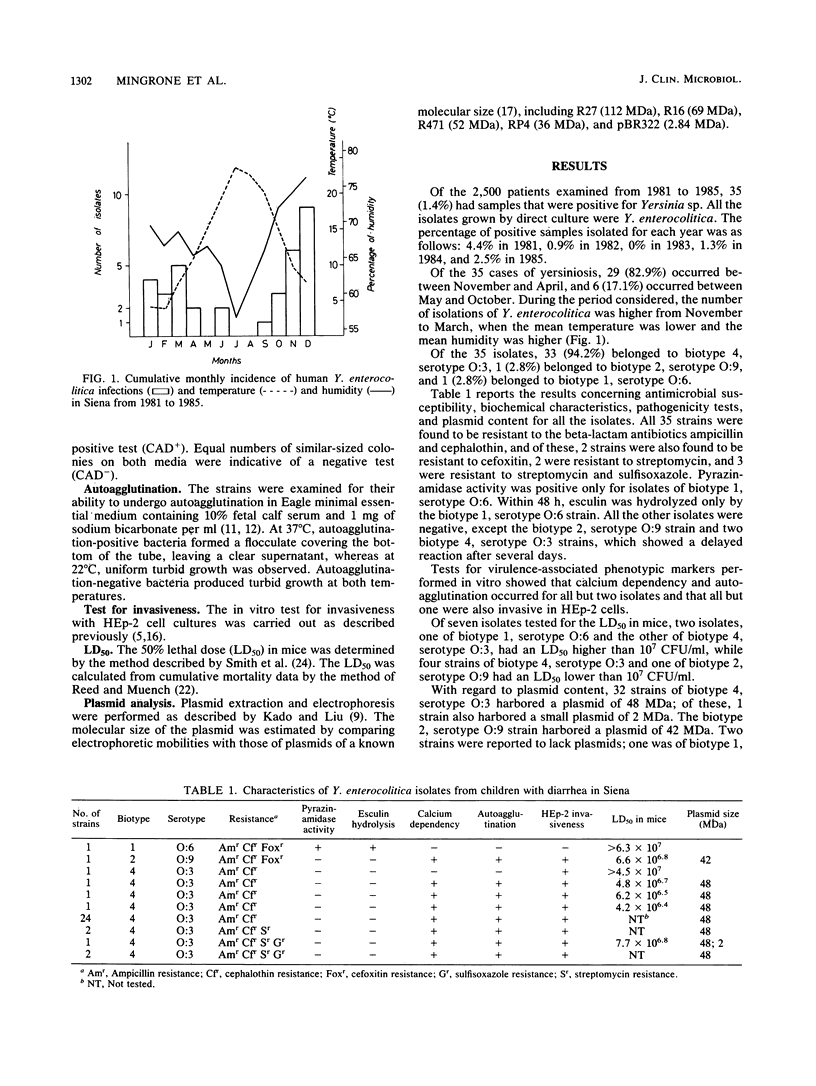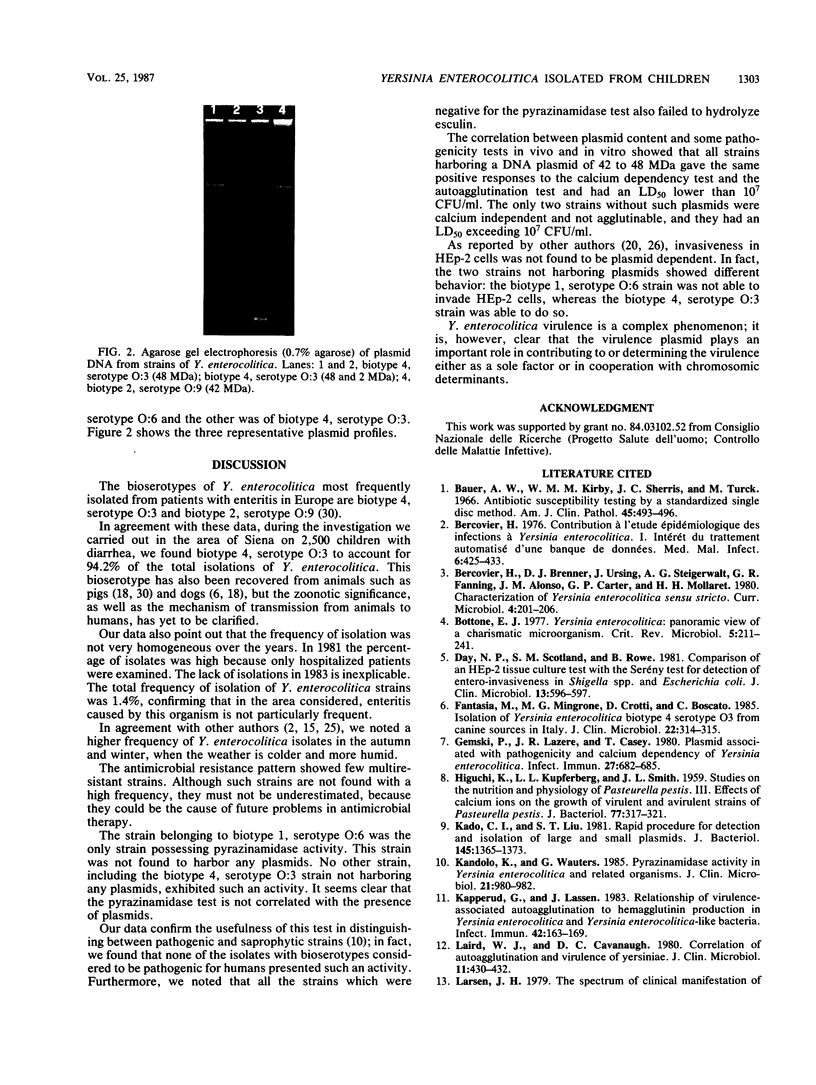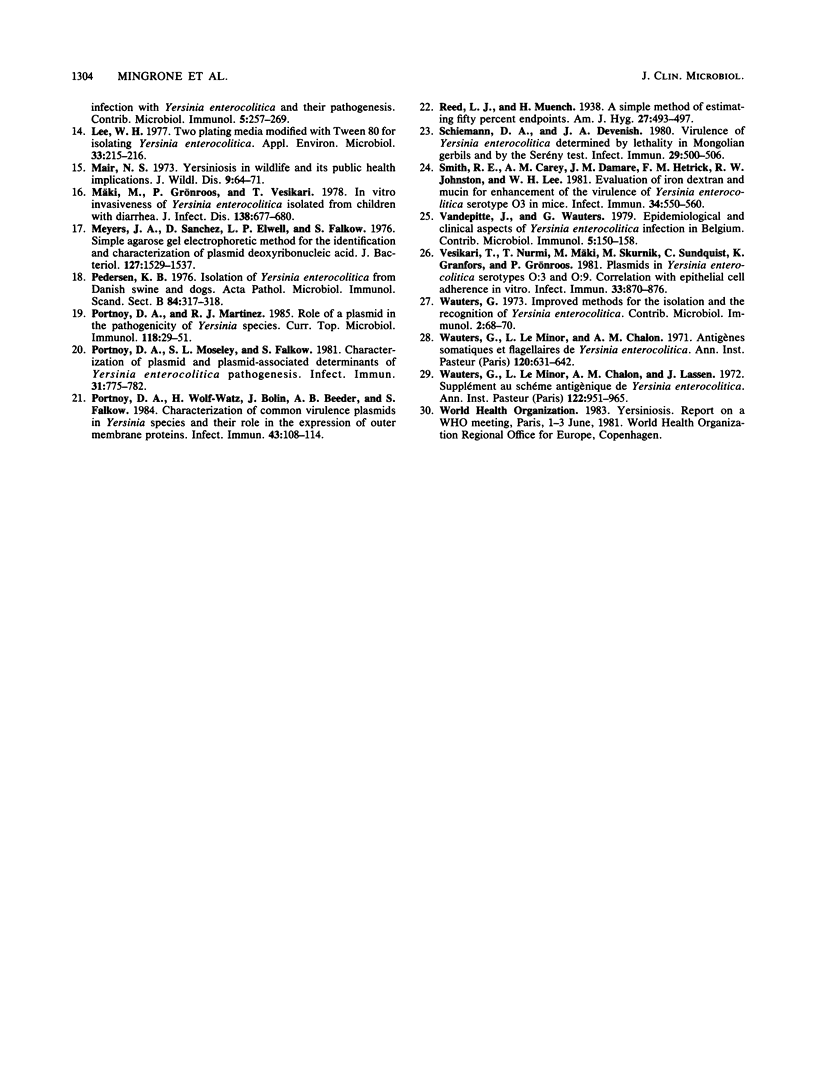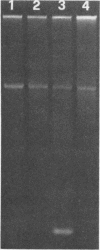Abstract
Of 2,500 fecal samples collected from children with diarrhea in the province of Siena, 35 (1.4%) were found to be positive for Yersinia enterocolitica. Of the isolates, 94.2% belonged to biotype 4, serotype 0:3; 2.8% belonged to biotype 2, serotype O:9; and 2.8% belonged to biotype 1, serotype O:6. The in vitro pathogenicity tests showed that all but two isolates were calcium dependent and autoagglutinable and that all but one were also invasive in HEp-2 cell culture. As regards plasmid content, 32 of 33 biotype 4, serotype O:3 strains harbored a plasmid of 48 megadaltons and 1 strain also harbored a small plasmid of 2 megadaltons. The biotype 2, serotype O:9 strain harbored a plasmid of 42 megadaltons; one of the two strans lacking plasmids belonged to biotype 1, serotype O:6, and the other belonged to biotype 4, serotype O:3. Pyrazinamidase activity was positive only for the biotype 1, serotype O:6 strain. Esculin was hydrolyzed only by the biotype 1, serotype O:6 strain.
Full text
PDF



Images in this article
Selected References
These references are in PubMed. This may not be the complete list of references from this article.
- Bauer A. W., Kirby W. M., Sherris J. C., Turck M. Antibiotic susceptibility testing by a standardized single disk method. Am J Clin Pathol. 1966 Apr;45(4):493–496. [PubMed] [Google Scholar]
- Bottone E. J. Yersinia enterocolitica: a panoramic view of a charismatic microorganism. CRC Crit Rev Microbiol. 1977;5(2):211–241. doi: 10.3109/10408417709102312. [DOI] [PubMed] [Google Scholar]
- Day N. P., Scotland S. M., Rowe B. Comparison of an HEp-2 tissue culture test with the Serény test for detection of enteroinvasiveness in Shigella spp. and Escherichia coli. J Clin Microbiol. 1981 Mar;13(3):596–597. doi: 10.1128/jcm.13.3.596-597.1981. [DOI] [PMC free article] [PubMed] [Google Scholar]
- Fantasia M., Grazia Mingrone M., Crotti D., Boscato C. Isolation of Yersinia enterocolitica biotype 4 serotype O3 from canine sources in Italy. J Clin Microbiol. 1985 Aug;22(2):314–315. doi: 10.1128/jcm.22.2.314-315.1985. [DOI] [PMC free article] [PubMed] [Google Scholar]
- Gemski P., Lazere J. R., Casey T. Plasmid associated with pathogenicity and calcium dependency of Yersinia enterocolitica. Infect Immun. 1980 Feb;27(2):682–685. doi: 10.1128/iai.27.2.682-685.1980. [DOI] [PMC free article] [PubMed] [Google Scholar]
- HIGUCHI K., KUPFERBERG L. L., SMITH J. L. Studies on the nutrition and physiology of Pasteurella pestis. III. Effects of calcium ions on the growth of virulent and avirulent strains of Pasteurella pestis. J Bacteriol. 1959 Mar;77(3):317–321. doi: 10.1128/jb.77.3.317-321.1959. [DOI] [PMC free article] [PubMed] [Google Scholar]
- Kado C. I., Liu S. T. Rapid procedure for detection and isolation of large and small plasmids. J Bacteriol. 1981 Mar;145(3):1365–1373. doi: 10.1128/jb.145.3.1365-1373.1981. [DOI] [PMC free article] [PubMed] [Google Scholar]
- Kandolo K., Wauters G. Pyrazinamidase activity in Yersinia enterocolitica and related organisms. J Clin Microbiol. 1985 Jun;21(6):980–982. doi: 10.1128/jcm.21.6.980-982.1985. [DOI] [PMC free article] [PubMed] [Google Scholar]
- Kapperud G., Lassen J. Relationship of virulence-associated autoagglutination to hemagglutinin production in Yersinia enterocolitica and Yersinia enterocolitica-like bacteria. Infect Immun. 1983 Oct;42(1):163–169. doi: 10.1128/iai.42.1.163-169.1983. [DOI] [PMC free article] [PubMed] [Google Scholar]
- Laird W. J., Cavanaugh D. C. Correlation of autoagglutination and virulence of yersiniae. J Clin Microbiol. 1980 Apr;11(4):430–432. doi: 10.1128/jcm.11.4.430-432.1980. [DOI] [PMC free article] [PubMed] [Google Scholar]
- Lee W. H. Two plating media modified with Tween 80 for isolating Yersinia enterocolitica. Appl Environ Microbiol. 1977 Jan;33(1):215–216. doi: 10.1128/aem.33.1.215-216.1977. [DOI] [PMC free article] [PubMed] [Google Scholar]
- Mair N. S. Yersiniosis in wildlife and its public health implications. J Wildl Dis. 1973 Jan;9(1):64–71. doi: 10.7589/0090-3558-9.1.64. [DOI] [PubMed] [Google Scholar]
- Meyers J. A., Sanchez D., Elwell L. P., Falkow S. Simple agarose gel electrophoretic method for the identification and characterization of plasmid deoxyribonucleic acid. J Bacteriol. 1976 Sep;127(3):1529–1537. doi: 10.1128/jb.127.3.1529-1537.1976. [DOI] [PMC free article] [PubMed] [Google Scholar]
- Mäki M., Grönroos P., Vesikari T. In vitro invasiveness of Yersinia enterocolitica isolated from children with diarrhea. J Infect Dis. 1978 Nov;138(5):677–680. doi: 10.1093/infdis/138.5.677. [DOI] [PubMed] [Google Scholar]
- Pedersen K. B. Isolation of Yersinia enterocolitica from Danish swine and dogs. Acta Pathol Microbiol Scand B. 1976 Oct;84B(5):317–318. doi: 10.1111/j.1699-0463.1976.tb01945.x. [DOI] [PubMed] [Google Scholar]
- Portnoy D. A., Martinez R. J. Role of a plasmid in the pathogenicity of Yersinia species. Curr Top Microbiol Immunol. 1985;118:29–51. doi: 10.1007/978-3-642-70586-1_3. [DOI] [PubMed] [Google Scholar]
- Portnoy D. A., Moseley S. L., Falkow S. Characterization of plasmids and plasmid-associated determinants of Yersinia enterocolitica pathogenesis. Infect Immun. 1981 Feb;31(2):775–782. doi: 10.1128/iai.31.2.775-782.1981. [DOI] [PMC free article] [PubMed] [Google Scholar]
- Portnoy D. A., Wolf-Watz H., Bolin I., Beeder A. B., Falkow S. Characterization of common virulence plasmids in Yersinia species and their role in the expression of outer membrane proteins. Infect Immun. 1984 Jan;43(1):108–114. doi: 10.1128/iai.43.1.108-114.1984. [DOI] [PMC free article] [PubMed] [Google Scholar]
- Schiemann D. A., Devenish J. A. Virulence of Yersinia enterocolitica determined by lethality in Mongolian gerbils and by the Serény test. Infect Immun. 1980 Aug;29(2):500–506. doi: 10.1128/iai.29.2.500-506.1980. [DOI] [PMC free article] [PubMed] [Google Scholar]
- Smith R. E., Carey A. M., Damare J. M., Hetrick F. M., Johnston R. W., Lee W. H. Evaluation of iron dextran and mucin for enhancement of the virulence of Yersinia enterocolitica serotype O:3 in mice. Infect Immun. 1981 Nov;34(2):550–560. doi: 10.1128/iai.34.2.550-560.1981. [DOI] [PMC free article] [PubMed] [Google Scholar]
- Vandepitte J., Wauters G. Epidemiological and clinical aspects of human Yersinia enterocolitica infections in Belgium. Contrib Microbiol Immunol. 1979;5:150–158. [PubMed] [Google Scholar]
- Vesikari T., Nurmi T., Mäki M., Skurnik M., Sundqvist C., Granfors K., Grönroos P. Plasmids in Yersinia enterocolitica serotypes O:3 and O:9: correlation with epithelial cell adherence in vitro. Infect Immun. 1981 Sep;33(3):870–876. doi: 10.1128/iai.33.3.870-876.1981. [DOI] [PMC free article] [PubMed] [Google Scholar]
- Wauters G., Le Minor L., Chalon A. M. Antigènes somatiques et flagellaires des Yersinia enterocolitica. Ann Inst Pasteur (Paris) 1971 May;120(5):631–642. [PubMed] [Google Scholar]
- Wauters G., Le Minor L., Chalon A. M., Lassen J. Supplément au schéma antigénique de "Yersinia enterocolitica". Ann Inst Pasteur (Paris) 1972 May;122(5):951–956. [PubMed] [Google Scholar]



